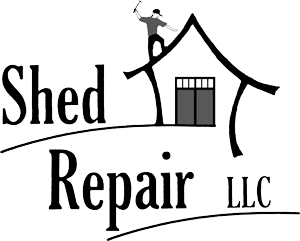That sinking feeling. You know the one. You glance out the window and see your old shed. Once a proud bastion of lawn tools and seasonal decorations, now a sagging, weathered monument to neglect. The door hangs crooked, a shingle or two are missing, and is that … mold?
Your sanctuary of storage, your extra bit of “breathing room,” is slowly succumbing to the elements and, with it, a piece of your homeowner’s peace of mind.

That leaky roof isn’t just a nuisance; it’s a constant worry about water damage. That warped siding isn’t just ugly; it’s a nagging reminder of your growing to-do list. Suddenly, your weekend project isn’t about planting flowers or grilling burgers; it’s about battling rot and decay.
If you’re staring at your shed with a mix of resignation and dread, you’re not alone. But where do you start? Repairing a shed can be a manageable DIY project for homeowners, and this comprehensive guide will explore how to tackle common shed issues. We’ll walk you through how to assess damage, tackle common shed problems, and provide a step-by-step approach to repair your shed. We’ll also help you decide whether a DIY approach is best by discussing the advantages of hiring a professional, such as Shed Repair, for those who want to ensure the job is done right.
Assessing the Damage
Before grabbing your toolbox and diving into repairs, a thorough inspection for any damage is crucial. Start by walking around your shed, noting any visible damage. Pay close attention to:
- Roof: Look for missing shingles, torn felt, sagging areas, and water stains on the underside.
- Walls: Check for rotting wood, holes, cracks, and signs of insect infestation.
- Floor: Inspect for soft spots, warping, and signs of water damage.
- Doors and Windows: Test hinges, latches, and seals. Look for rot and warping.
- Foundation: Examine for cracks, settling, and signs of shifting.
Inside: Look for structural issues like bent or broken supports and beams.
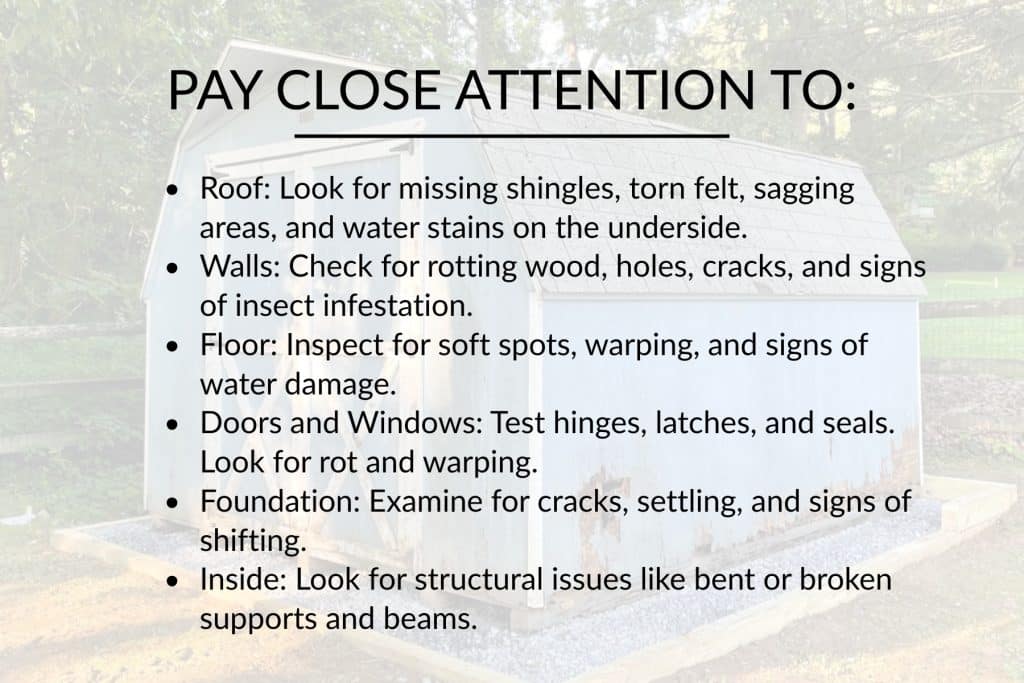
Document your findings with photos and detailed notes. This will help you create a repair plan and estimate material costs.
Tools and Materials Needed to Assess Damage
- Flashlight
- Ladder
- Tape measure
- Notepad for taking notes
- Camera
Fixing Common Shed Problems
Now, let’s dive into tackling the most common shed issues:
Roof Leaks
Roof leaks are prevalent in sheds and can lead to further damage if not addressed promptly. To repair a leaking roof:
- Identify the Source: Check for missing or torn shingles.
- Minor Leaks (Missing Shingles/Torn Felt): Remove the damaged shingles, clean the area, apply roofing cement, and replace missing felt or shingles. Apply roofing cement to seal around the edges of new shingles and at any joints to prevent future leaks.
- Major Leaks (Sagging Roof/Extensive Damage): This may require replacing entire sections of the roof. If you’re comfortable working at heights or have roofing experience, you can tackle this yourself. Otherwise, calling a pro is recommended.
Rotting Wood
Wood rot is another common problem, often caused by moisture exposure over time.
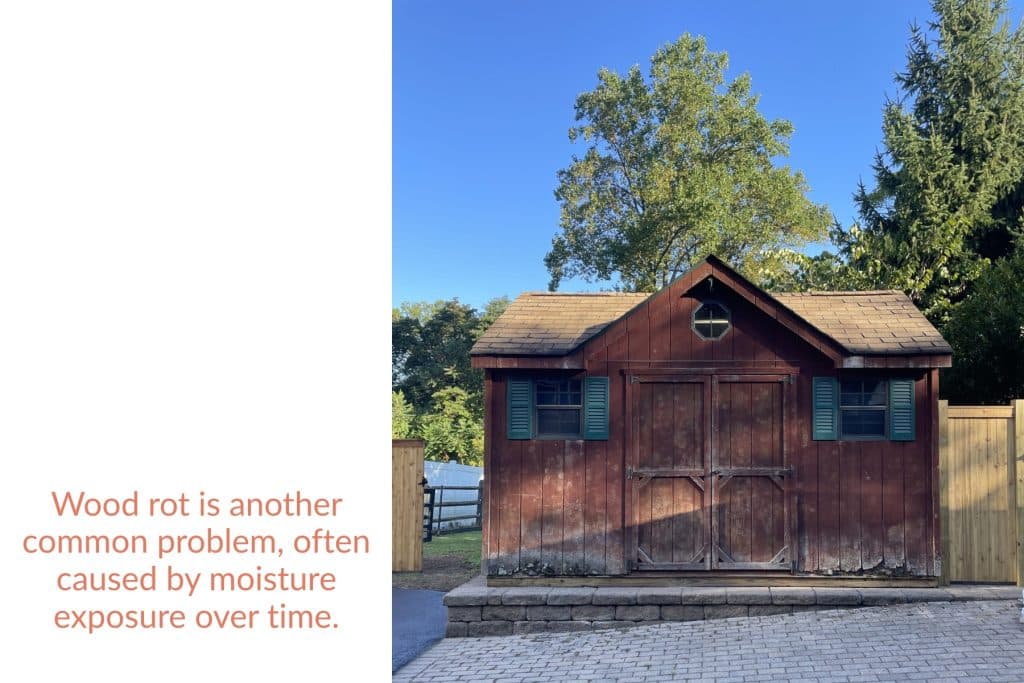
- Remove Rotted Sections: Remove the rotted wood carefully with a chisel or saw. Be sure not to damage the surrounding areas.
- Treat the Area: Treat the remaining wood with a wood preservative or apply a wood hardener to strengthen it. Fill any void with epoxy filler or a wood patch.
- Extensive Rot (Structural Damage): Replacing entire sections of framing or siding may be necessary. Install new, pressure-treated wood that resists moisture and decay. For structural repairs, experience with carpentry is recommended. A professional can ensure the repairs are done safely and correctly if you feel unsure.
Broken Doors and Windows
Fixing a broken shed door can improve the security and functionality of your shed.
- Assess the Damage: Determine if the door or window can be repaired or needs replacement.
- Hinge/Latch Issues: Tighten loose screws or replace damaged hardware, especially if the door is sagging.
- Warped/Rotting Doors/Frames: Replace the damaged components. Ensure proper sealing to prevent future water damage.
- Install a New Door: If the door is beyond repair, consider installing a pre-made door or building a new one from scratch.
- Broken Window Panes: Replace the glass pane with a new one, ensuring a proper seal.

Tools and Materials: Gear Up for the Task
Your tool and material list will vary depending on the extent of the damage. Here’s a general overview:
- Tools: Hammer, screwdriver set, pry bar, chisel, saw (circular or handsaw), drill, level, measuring tape, caulking gun, and ladder.
- Materials: Roofing shingles/felt, roofing cement, wood preservative, epoxy filler, wood patches, replacement lumber, nails, screws, caulk, and weather stripping.
Step-by-Step Guide for Repairing and Reinforcing a Shed
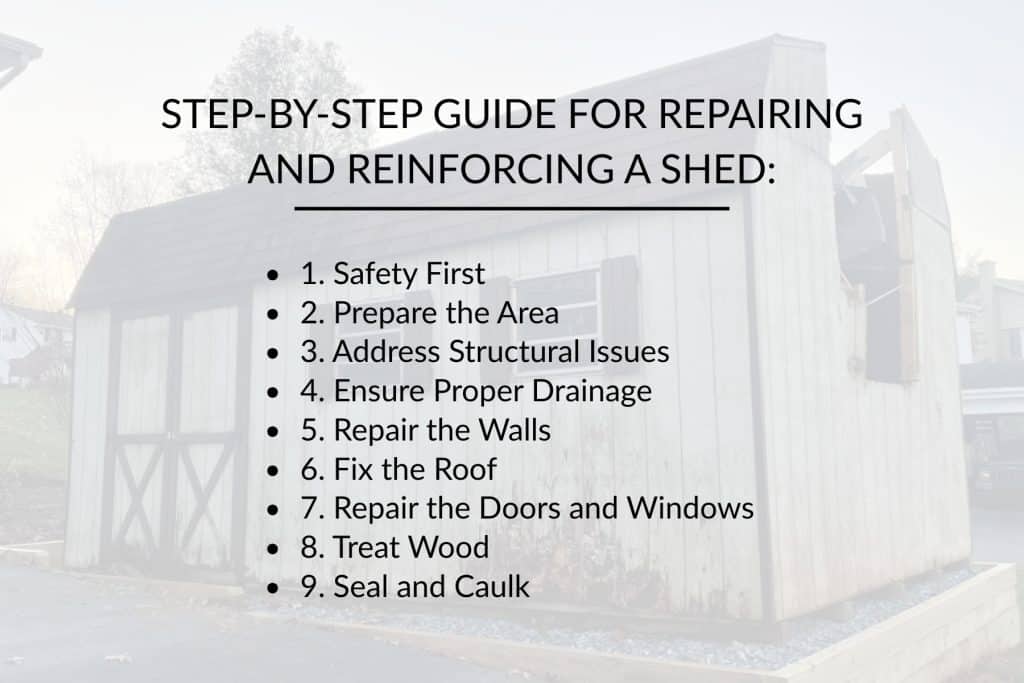
After addressing specific problems, it’s essential to reinforce the structure to prevent future issues.
- Safety First: Wear safety glasses, gloves, and appropriate footwear.
- Prepare the Area: Clear debris and remove any damaged materials.
- Address Structural Issues: Begin with the foundation and framing. Reinforce any weak frames by adding additional support. Ensure the shed is level and structurally sound.
- Ensure Proper Drainage: Ensure the area around the shed slopes away from the foundation to prevent water buildup, which can cause mold issues.
- Repair the Walls: Replace rotted siding, patch holes, and seal cracks.
- Fix the Roof: Repair or replace damaged shingles or felt. Reinforce sagging areas.
- Repair Doors and Windows: Replace damaged hardware and seal any gaps.
- Treat Wood: Apply a weather-resistant stain or sealant to protect exposed wood surfaces from moisture and pests.
- Seal and Caulk: Apply caulk around windows, doors, and seams to prevent water intrusion.
Preventing Future Damage
Preventive measures are crucial in extending the lifespan of your shed.
- Regular Inspection: Conduct annual inspections to identify and address any signs of damage or wear early.
- Immediate Repairs: Address minor issues immediately before they become more significant problems.
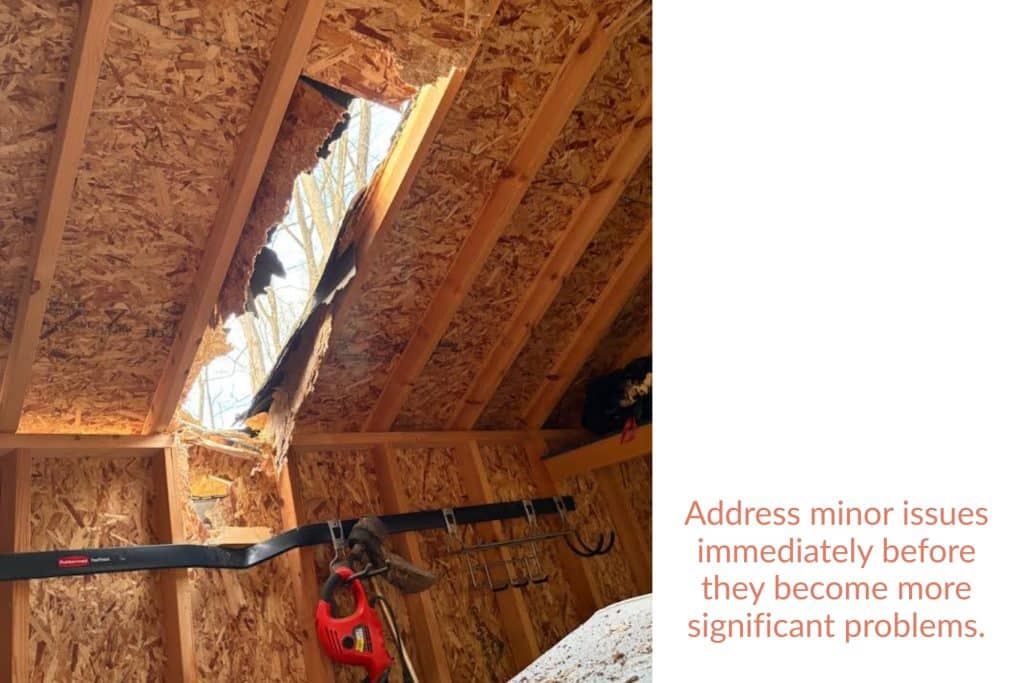
- Pest Control: Look for signs of pests and address any infestations quickly to prevent structural damage.
- Proper Ventilation: Ensure adequate ventilation to prevent moisture buildup.
- Maintain the Roof: Keep the roof clean and free of debris.
- Protect Wood: Apply a weather-resistant sealant or paint to wood surfaces.
- Address Drainage: Ensure proper drainage around the shed to prevent water pooling.
- Keep it clean: Remove debris from around the shed.
Should I Hire a Professional?
For DIY enthusiasts, repairing a shed can be a fulfilling project. Still, it requires tools, time, and a certain level of skill to ensure it’s done correctly. It’s essential to consider your skills, time, and the complexity of the project.
DIY Benefits
- Cost savings on labor
- Personal satisfaction of completing the project
- Flexibility to work on your own schedule
- Greater control over the outcome
DIY Drawbacks
- Requires experience and skill, especially for structural repairs.
- Time-consuming, especially for extensive damage.
- Potential for mistakes that could lead to further damage.
- Need to acquire the right tools.
Because of these drawbacks, hiring a professional might be the best choice if you want a guarantee that your shed will withstand the test of time and harsh weather conditions.
Benefits of Hiring a Professional
- Expertise and Experience: Professionals bring years of experience and can spot potential issues that might be missed by a novice.
- Time Savings: Hiring a professional can save a considerable amount of time. Instead of spending weekends and evenings working on the shed, you can have it repaired efficiently and correctly in less time.
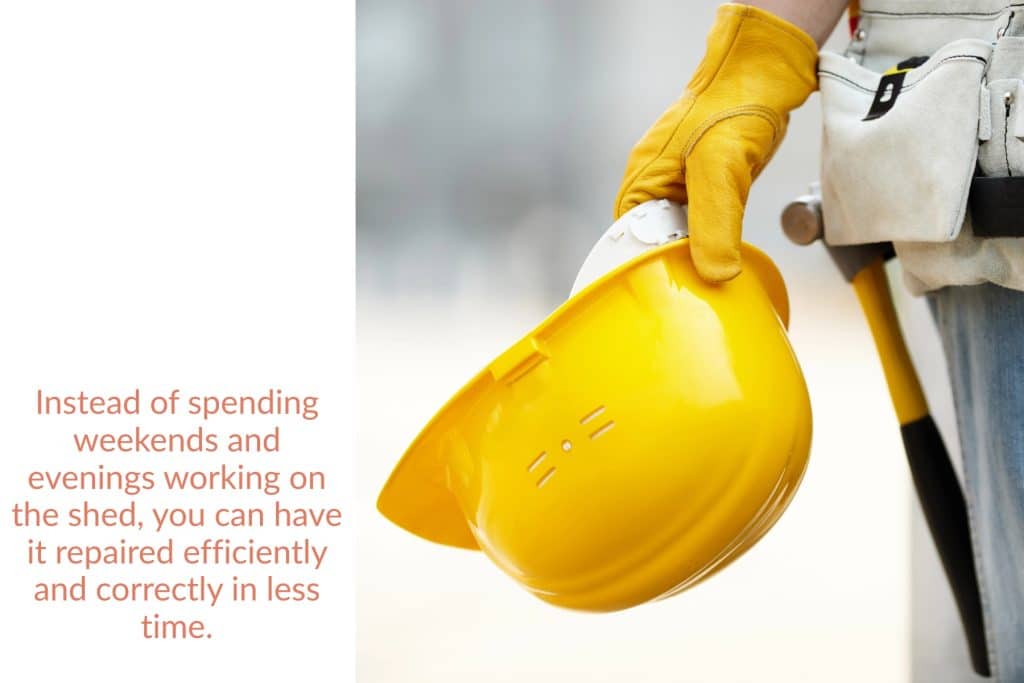
- Quality and Assurance: Professionals guarantee quality work that lasts. They use high-quality materials and techniques that might not be accessible to the average homeowner. They also often provide warranties for their services, giving you peace of mind.
- Necessary Tools: Professionals already have the proper tools and equipment, which ensures the job is completed correctly and safely.
Drawbacks of Hiring a Professional
- Cost: Hiring a professional will entail a higher cost compared to DIY.
- Timing: Using a professional requires you to fit into their schedule.
- Risk: Sometimes “professionals” don’t do good work, which makes it important to hire a company with a good reputation.

When to Hire a Pro
Knowing when to tackle a shed repair project yourself versus calling in a professional can be tricky. Still, certain situations clearly demand expert intervention, such as:
- Extensive structural damage.
- Roof repairs requiring significant height or expertise.
- Complex electrical or plumbing work.
- You lack the necessary skills or tools.
- You do not have the time to complete the project.
- You want the peace of mind of a job done correctly.
Conclusion
Whether you choose to DIY or hire a pro, the goal is to restore your shed to its former glory, providing you with functional and reliable storage space. Taking the time to assess the damage, repair issues promptly, and invest in preventive measures means you can extend the life of your shed and enhance your home’s outdoor space. Understanding the common shed problems and the options available allows you to make an informed decision and ensure your shed remains a valuable asset for years. Whatever your choice, a well-maintained shed is an invaluable asset to any home.
That’s where we come in. At Shed Repair, we’ve got the tools and the expertise to restore your shed. You don’t have to demolish your shed and replace it or buy expensive tools and spend your time repairing it yourself. Just get a free quote from us, and we’ll get in touch.
Let’s be honest: a well-maintained shed isn’t just about practicality. It’s about preserving a little piece of your personal space, whether it’s a haven for your tools, a workshop for your hobbies, or simply a place to escape for a moment. It’s a testament to the fact that you care about your space and keeping things in good shape.
Contact us at Shed Repair today! We look forward to helping you get your shed back in working condition.
